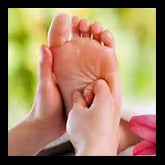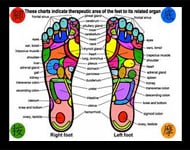
What is reflexology?
Refloxology is a form of energy work. It uses specific point work applied by thumbs and fingers to the hands, feet, and ears.
The body’s internal systems and organs can be located on the hands, feet and ears. Because of this, this energy healing therapy provides relief to a point’s corresponding organ or system.
Benefits
The benefits of reflexology start with the fact that it works the entire body. By manipulating points in the hands, feet or ears via reflex zones and nerve paths, energy is restored.
Reflexology benefits the recipient by clearing energy blocks in the channels (meridians). This allows the life-force energy to flow to and from each area of the body.
With restored positive energy flow, the body is able to work start healing itself. The reflexology treatment is non-invasive and relaxing.
For quick reference, below is a list of common health concerns addressed through reflexology. Experiences and results will vary.
- acid reflux
- anxiety
- back pain
- breathing difficulties
- bronchitis
- constipation
- depression
- digestive issues
- emotional imbalance
- fatigue
- headache
- hearing loss
- irritability
- low energy
- migraine
- neck pain
- sciatica
- sinusitis
- thyroid imbalance
- tinnitus
Booking a treatment
As with all alternative medicine therapies, tell your therapist about your medical history.
Confirm prior to booking your appointment that you don’t have any contraindications for the treatment you want. If you are unsure, ask your physician or therapist prior to receiving the treatment.
If you are pregnant, avoid reflexology.

What to expect for a reflexology service
Unless your service is at a spa where you change into a robe, you’ll remain dressed for reflexology. If this is the case, wear shorts, or something comfortable and easy to roll up.
Depending on the environment, you might be laying (face up) on a massage table without covers. However, most of the time, a blanket or towel will cover you while they work.
The reflexology procedure will vary between establishments. And, although reflexology may be performed otherwise, it is most commonly performed on the feet.
This example is provided for basic understanding and includes only reflexology to the bottoms of the feet. Please note that this is not a typical massage service.
Typical reflexology treatment
Often the therapist will start by providing an exfoliating foot-to-knee scrub or foot bath to relax the feet. After cleaning and drying them, they will begin the reflexology.
Working one foot at a time, they will follow a pattern. Beginning at the top of the foot, they’ll work their way down through the heel, point by point. They will then repeat the process to the second foot before ending the session.
During your service, massage may be included of the legs (from the knee down) and feet. At a spa, the longer reflexology treatment usually includes massage of the neck, arms, and hands.
As mentioned above, reflexology is relaxing. However, when the body is fighting something, areas on the foot may be sensitive. If so, crystalline deposits can form in the area related to the organ or system that is out of balance.
These points will be sensitive to touch and may be referred to as foot reflexology pain. Despite any discomfort, these areas need to be manipulated to break up the crystals and increase energy flow. Breathe deep and allow the therapist to work the point sufficiently for best results.
Additionally, feel free to ask which organs or systems are being worked when you experience pain. Tenderness and extreme sensitivity could be (not always) indicative of an underlying issue that needs medical attention.
After the service, consider following up with your doctor if it’s something new to you.

After your treatment and how often to have one
Reflexology will put you in a state of relaxation and your feet will feel great.
If you’re expecting noticeable results for something, expect about 24 hours for the effect to take place. A few will experience relief during the service, but this is rare.
Increase your intake of water and decrease the intake of alcoholic beverages, caffeine, sugar and processed foods.
Address your body’s needs. Pay special attention to those discovered during the treatment.
Learning to work with the body naturally, can help it to heal itself. This, in turn, can often prevent harsher, more invasive methods of dealing with an illness or concern.
Unless advised otherwise by your therapist, enjoy reflexology treatments for relaxation as often as possible.
Relieve symptoms with reflexology
If you are working to relieve symptoms or heal an area of concern, then consult your Reflexologist for treatment frequency and adhere to their suggestion.
This may require a commitment of an initial 10-12 treatments, starting with twice a week then backing out to once a week or twice a month. If this is the case, it is because the system is trying to correct itself.
Similar to acupuncture, the point’s energy is drawn to the surface, expediting the healing process.
The longer the time in between sessions, the more the energy will “recede” back into your body. Each session calls the energy back up, so the closer together, the more accessible the energy to work with.
Spacing treatments out considerably can prolong the healing process.
Remember, it takes time to exhaust part of the system to finally see the symptoms; therefore, it will take time to reverse the damage. Be patient for results.
Categories for Reflexology Massage
Alternative Therapies
Energy Healing Techniques
Types of Massage
As an affiliate, we earn a small commission for qualifying purchases via links on this site. The commission is paid by the advertiser and does not affect the price of the product or cost the consumer. It is how we help pay to keep this site free to use!
